Donor Pledges $1 Million for Lake Park Bridge
But anonymous East Side philanthropist demands closing Ravine Road to vehicle traffic.
An anonymous donor has dramatically changed the complex question of how to handle the historic but deteriorating Lake Park Arch Bridge.
An East Side resident wants to donate $1 million toward replacing the Ravine Road pedestrian bridge, which some Milwaukee County officials immediately embraced and some parks supporters immediately opposed. County Supervisor Sheldon Wasserman announced Wednesday at a meeting of the Historic Water Tower Neighborhood Association that an anonymous neighbor has offered to help underwrite a “replica” of the Ferry & Clas-designed bridge. However, he noted, the pledge is contingent on the county banning vehicular traffic on the short, winding road connecting Lincoln Memorial Drive to bluff areas of Lake Park. Instead, only pedestrians, bicyclists, and other non-motor uses would be allowed. Some attendees immediately gasped “No!” in response to the proposed road closure.
But Abele and county parks director John Dargle have taken no position so far on whether to accept the donation with its strings attached.
Members of the Lake Park Friends opposed the idea, as Colleen Reilly, vice president of the group explained at the meeting. The group passed a resolution which declares it is the “responsibility of Milwaukee County to build, repair, and maintain roads, bridges, and other infrastructure within the park lands owned by Milwaukee County… Lake Park Friends does not support any proposal to have private citizens fund the replacement of any park infrastructure.”
The resolution further noted that “Ravine Road should be reopened to vehicular traffic as it was an integral part of the original park design by Frederick Law Olmsted.”
Since its founding in 1996, the 500-member, volunteer-led Lake Park Friends “has contributed nearly $750,000 for capital projects and programming for the entire community’s enjoyment of Lake Park,” Alice Wilson, its president, told Urban Milwaukee. Friends-funded projects include the Ravine Waterfall, a performance stage and tree planting throughout the 138-acre park, as well as annual underwriting of the ice rink, summer music programs and tennis scholarships.
Wasserman was an invited speaker at Wednesday’s Historic Water Tower Neighborhood Association meeting. The 160-member group represents the neighborhood bounded approximately by East Edgewood Avenue, North Downer Avenue, East Lafayette Place and Lake Michigan. Barbara Elsner, who cofounded the group in 1973, said after the meeting, “It is an alarming precedent that a donor could demand dramatic changes to the design of a historic park.” The nonagenarian has lived near Lake Park since her family moved to the neighborhood when she was in third grade.
Elsner questioned why federal funding is not being sought for the project. Bob Schmidt, a Wisconsin Department of Transportation official, previously told Urban Milwaukee that either bridge rehabilitation or a replacement would likely qualify for Federal Transportation Alternatives Program (TAP) grants, in different categories. January 2018 is the next application deadline in the two-year grant cycle. Haley has said that another county parks project is likely on deck for a TAP application.
Following deliberations by an appointed “Ravine Road Bridge Work Group,” county officials are favoring a replacement bridge—instead of repairing and preserving the existing bridge. Nonetheless, Carlen Hatala, the City of Milwaukee’s historic preservation planner, recently wrote in a statement about the bridge, “It makes no sense to think of a historic resource as expendable…Demolition is the last resort and all efforts must be made to repair and retain” it.
In addition to being listed on the National Register, both the bridge and park are in a designated local historic district. Thus, any bridge plan must be reviewed by Milwaukee’s Historic Preservation Commission and Wisconsin’s State Historic Preservation Office. Also, Milwaukee County Parks’ Historic Properties Management Plan, developed in 2013 with Wisconsin’s Department of Transportation, states that “Rehabilitation should always be considered as the preferred treatment for a historic bridge.”
Laurence Cotton, writer/producer of “Designing America,” a PBS documentary about Olmsted, has noted that Lake Park is one of Olmsted’s most-intact landscapes nationwide, along with Manhattan’s Central Park and Boston’s Emerald Necklace parks.
Wasserman told Urban Milwaukee he floated this proposal because he believes it is his “fiduciary responsibility” to consider any offer relating to the bridge. Wasserman said the prospective donor and his family have enjoyed walking on the closed Ravine Road.
Asked by a meeting attendee if bridge and road proposals would be heard by the county board or parks committee, Wasserman said none is currently planned. But he later told Urban Milwaukee, “Of course, there will be an open hearing” about possibly closing the road and “all groups and individuals advocating for this park and neighborhood will be able to weigh in.”
Recently retired county supervisor Pat Jursik told Urban Milwaukee it’s not appropriate to use the budget process to enact de-facto “policies about public-good issues.” She said there should be public hearings about the bridge and road, separate from budget deliberations.
Other recent developments may be relevant to Ravine Road Bridge issues:
- Konstantin Sobolev, professor and chair of UW-Milwaukee’s civil and environmental engineering department, has begun exploring potential preservation solutions for the Ravine Road Bridge as a pro-bono project. He told Urban Milwaukee he has met with Milwaukee County engineering staff and offered to oversee such research. Sobolev is a recognized expert on innovative concrete materials and says colleagues in national engineering circles have expressed concern that a bridge with such engineering and design significance might be demolished.
- The appointed Ravine Road Bridge Work Group recommended in September to raze the bridge and replace it with one based on the original design. Representatives of four parks and neighbor groups agreed to support that option. Kevin Wood, a Graef USA engineer who chaired the committee’s meetings, said in September that about $200,000 of $400,000 allotted for “bridge study and design” has been spent. He estimated that interim bridge repairs–to allow the road to safely reopen–would cost about $25,000. However, such repairs would require a new allocation since they cannot draw on capital funding. Wasserman told Urban Milwaukee this week he does not think a “short-term fix” is going to happen. He believes the county does not want to open Ravine Road before completing a long-term solution.
New methods to repair concrete bridges–“fiber wrapping” and “shotcrete”–were used to rehabilitate the historic Marsh Rainbow Arch Bridge in Chippewa Falls, Wisconsin. Completed in September, the $841,000 project received city, state and federal funding. The Chippewa Herald reported that a city official said that price tag “was much better than the alternative—the $3-4 million it would have cost to build a new bridge that looked the same as the current one.”
Correction: An early version of the story incorrectly suggested parks director John Dargle enthusiastically supported using the $1 million donation. He has so far taken no stand on this.
Lake Park Arch Bridge
More about the Ravine Road Bridge Project
- City Should Enforce Reopening of Ravine Road, Park Friends Say in Filing - Lake Park Friends - Sep 28th, 2023
- MKE County: Ravine Road Debate Heats Up - Graham Kilmer - Aug 14th, 2023
- MKE County: Ravine Road Project Could Begin in 2024, With Pedestrian-Only Option - Graham Kilmer - Aug 1st, 2023
- MKE County: Lake Park Bridge Open For First Time In 6 Years - Graham Kilmer - Oct 29th, 2022
- Friday Photos: Lake Park Bridge Overhaul Nears Completion - Jeramey Jannene - Sep 23rd, 2022
- MKE County: Lake Park Bridge Needs $1 Million More - Graham Kilmer - May 18th, 2021
- County Receives $2 Million Grant for Lake Park Bridge - County Executive Chris Abele - Sep 12th, 2018
- County Parks To Seek State Grant to Fund Ravine Road Bridge Project - Milwaukee County Parks - Feb 8th, 2018
- Op-Ed: Lake Park’s Bridge Spans History - Paul Daniel Marriott - Apr 5th, 2017
- Public Forum For Lake Park Bridge - Virginia Small - Feb 13th, 2017
Read more about Ravine Road Bridge Project here


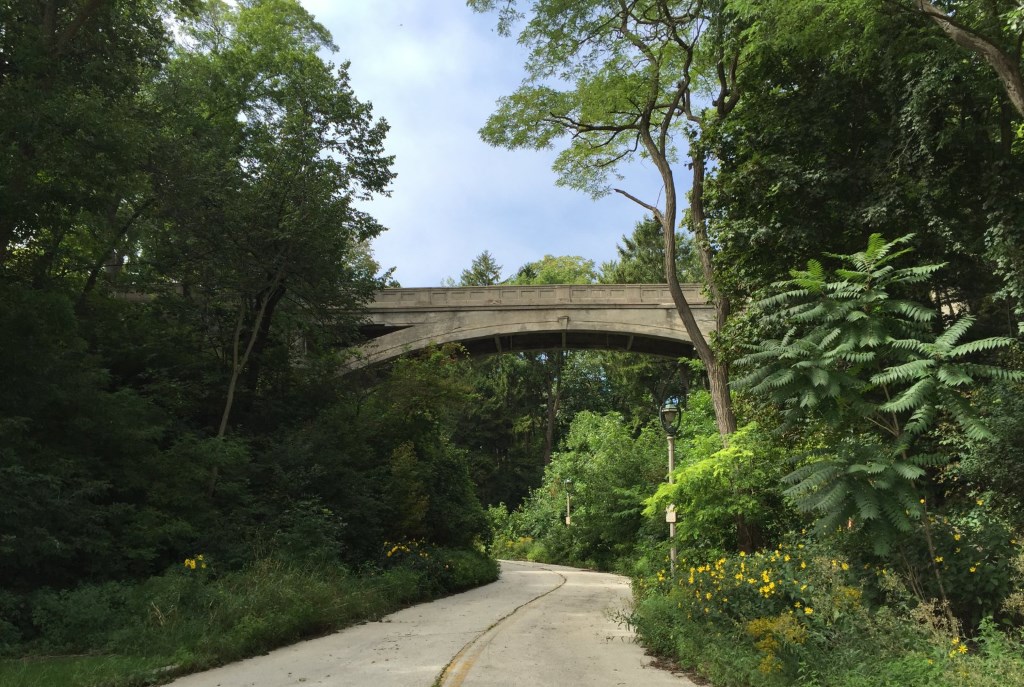
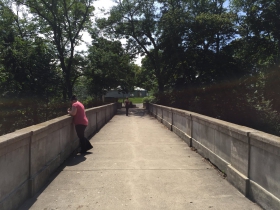
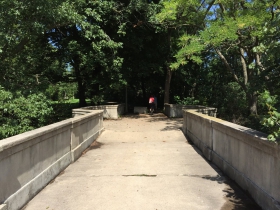
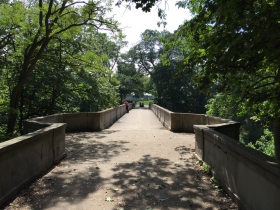
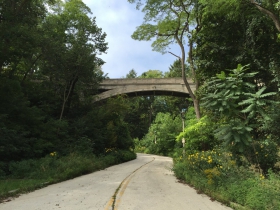
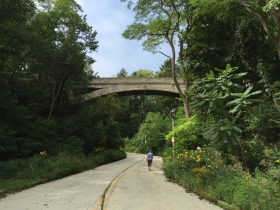
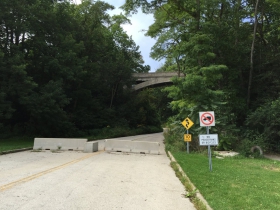


















Fredrick Law Olmsted died in 1903. Production of the Ford Model T began in 1908. Relying on Olmsted’s original, 19th century vision to justify automobile traffic through the park in 2016 is, at the very least, ahistorical.
I can’t say I’ve ever been to a park and thought my experience would be improved by a road cutting through the middle to reduce commuting times of the neighbors.
And the statement, “Lake Park Friends does not support any proposal to have private citizens fund the replacement of any park infrastructure”? I don’t even know where to begin.
They sure draw a very fine line for themselves, don’t they?
Lake Park Friends opposes closing Ravine Road to motor vehicles because “Ravine Road should be reopened to vehicular traffic as it was an integral part of the original park design by Frederick Law Olmsted.”
Olmsted never designed Ravine Road for automobiles, as they had just been invented (in 1885, 7 years before Lake Park was designed) and were still rare novelties. The vehicular traffic had in mind was horses and buggies.
I wish I could “like” Daniel and Tom D.’s comments. I don’t think Olmsted ever imagined commuter traffic speeding up and down that road to Lincoln Memorial Drive. It has been wonderful having that road closed and not having to worry about cars flying by when entering or exiting the park on foot. The road would be a great, safe way for walkers/bikers to get down to the lakefront, especially for those who are very young, older, or disabled and can’t manage the stairs or trails.
What could be more wonderful than a ride through the park on you bike, or a walk way to the Lake?
Or even open it to horses…sure our Sherriff would welcome bringing his horse to the park!
The Ravine Road was a race track, there was no sharing with pedestrians or cyclists. Do we really care if cars need to go another 3 blocks south to get on to Lincoln Memorial which has also become a highway?
God protect the poor cyclist that attempts to share the road with the vehicles.
Come on everyone, this IS A PARK, let’s use it as such, NOT as a highway entrance.
I WELCOME the change – we have enough roads.
If I understand correctly, the bridges carried vehicularbtraffic before becoming pedestrian/bicycles only. Seems like a precedent.
Urbanemilwaukee should take this dog and pony show, and the Estabrook dam verision, to stages around the country, beginning with the Pabst Theater. You could rotate constituencies or really ramp it up with everybody on the stage.
A recent addition to MPL shelves illustrating similar community obstructionism is called “The new Rijksmuseum” [DVD videorecording] / a film by Oeke Hoogendijk. It’s really entertaining. Their project stretched from a projected 5 years to c. 10 years and many millions over budget.
From the MPL catalog description: “… The museum battled politicians, designers, curators and even the Dutch Cyclists Union as the workers struggled to complete the job. …”
I don’t know Gary…if you want to talk about running projects past their due date, we should probably get Governor Walker on the line and ask how we’re doing on the zoo interchange.
I am going back to 1945 when my “GIRLFRIEND” and I used this wonderful road to walk on during our courting days. At that time, there were very few cars that I can recollect which drove up or down the road. In my long time residency in Milwaukee, I have seen too many HISTORIC buildings and “ICONIC” structures from the PAST destroyed because of some NEWcomers to Milwaukee who do not appreciate the historic history that our wonderful city has.
I say, “keep the BRIDGE”, and repair as necessary, but also PROHIBIT MOTOR VEHICLE traffic after the repairs are made.
LEONARD SONNY MARCUS
It’s long been my understanding that any external money or profits accrued by Milwaukee County must go into the General Fund and cannot be earmarked. (Profits from the very lucrative airport, for example.) Am I wrong?
Mark Goff (post 10): Federal regulation prohibits any money from flowing from the airport to general County coffers. Keeping airport money at the airport is a condition of getting federal avation subsidies.
There are similar restrictions for transit funding. The County can’t buy buses with federal subsidies and then turn around and sell them on the open market, for example.
keep vehicular traffic…build path for bikes and pedestrians if possible. that road is very functional.
@Mark Goff (#10)
In response to your comment about whether the County could accept money designated for a specific purpose. I understand that it would require county board approval since they would have to create a balance-sheet account that would stipulate the donation as being reserved for a specified project rather than the money dropping to the bottom line.
A nonprofit (such as a foundation) could also serve as the “vessel” for a donation, which is a common way for parks departments to receive donations. That’s one way gifts to can be restricted to the intent of a donor. Of course, the nonprofit would have to vote to accept the money and its restricted use and be willing to serve as the pass-through.
Chippewa Falls repaired their historic bridge for under $100k instead of a $3.5 million rebuild. How short sighted of Milwaukee County to think an estimated $2.5 million rebuild won’t escalate. Certainly the contractors expect over-runs and more fees.
The ELEPHANT in the county board room is GREIF Architecture, with their busy sales team spewing bad advice and grabbing lucrative county contracts at $50k-200k each to research dead-end projects. GREIF is bleeding the county with dubious research and designs on their own corporate gravy train.
GREIF does NOT DO historic restoration. They should not get contracts for historic sites. All they can do is DESIGN NEW stuff and DEMOLISH our landmarks. Why do WE pay for Greif’s useless design and biased advice? STOP the GREIF-VY TRAIN.
Let’s get OTHER ENGINEERS to study this bridge like UW-Milwaukee’s Civil Engineering department, who offered to explore preservation solutions pro bono. This is great news. There are federal GRANTS to preserve historic sites. Let go and get them. STOP the GREIF-VY TRAIN.
Correction. The architectural elephant in the Milwaukee County board room is Graef and Associates of Milwaukee, WI.
STOP the GRAEF-VY TRAIN
There are several paths through the park. Can we have just this one road for cars, please?
It will literally take you 2 minutes to drive around, it’s now a beautiful and peaceful walk since the bluff shields you from the road noise. mbradleyc, take a few minutes to walk it yourself, time well spent!
It should be made clear that Historic Water Tower did not take a position on closing the road to cars, but I would judge from comments and a show of hands that a majority liked the idea. Clearly there was a difference of opinion.
As to repairing the bridge, earlier discussions led to the conclusion that there was little that could be salvage and that was mainly structural that would be hidden from view. Majority supported a modern replica of the original bridge. The idea of a modern design that tried to capture the S&C spirit gained little attraction (other than from me).
mbradleyc (post 16):
Why do you want motor vehicles on Ravine Road—as a shortcut or to enjoy the park?
If it’s for a shortcut between Newberry/Lake Dr and Lincoln Memorial Dr, then just access Lincoln Memorial 3 blocks north at Kenwood.
If it’s to experience the park’s beauty from the comfort of your automobile, then how about a compromise—open it to cars, but convert it to a vehicle cul-de-sac? (Pedestrians and bicycles could pass through but cars would be forced to turn back at either the top or bottom.) This would eliminate 95% of the vehicular traffic, giving walkers most of the quiet they seek, while still providing your road to enjoy the park.
I still think a total motorized vehicle ban on Ravine is a best idea, but I’m interested in your reaction to a compromise cul-de-sac.
I never gave thought to a CUL DE SAC! That’s a great idea. Repair the bridge and have a CUL DE SAC at the top for a “turn around PLUS a LARGE sign at the BOTTOM, saying NO OUTLET >
sonny marcus
Of the many thoughtful comments above I believe Gloria hit the nail head squarely. Graef, Inc. is eating up funds that would be better spent improving our park system. Our parks are woefully understaffed and that’s the rationale used for bringing in for-profit “experts” to perform functions that should be done by our parks dept. Between that practice and attempting to turn our parks into revenue generating resources, the County Executive continues to misunderstand the intent of our park system founders, as well as the our taxpayer’s expressed willingness to better fund our parks. (a referendum advocating a 1/2cent sales tax dedicated to funding parks passed in 2008, but was ignored by the state at the behest of the MMAC.
Tom D, to enjoy the park. That drive is beautiful. I like to take visitors along LMD from downtown, then swing them up through the park on Ravine, head out to Lake Drive, turn north back to LMD and then drive back down to downtown. That is an awesome drive and it shows off Milwaukee like they couldn’t have imagined.
That’s what I like to do.
Regardless of when it was built, if it was meant for horse and buggies or cars, it isn’t a walking bath or a bike trail. It’s a road. What’s the harm in keeping it?
We just disagree.
I’ll be frank, the reason some people want to close Ravine Road is to keep west-bound auto traffic off of Newberry Blvd., which connects to Ravine Road just east of Lake Dr. The road is a convenient route to and from the lakefront for east siders AND citizens from other parts of the Milwaukee area.
I live one block from Newberry Blvd., and drove daily down Ravine Road to Lincoln Memorial Drive.
The presence of non-neighborhood residents accessing Lake Park via Newberry Blvd. and nearby East Locust St. is a good thing. I have not noticed a lot of speeders on Ravine Road, Newberry Blvd.or East Locust St. over the 25 years I’ve lived in the neighborhood.
Similar NIMBY sentiments have inflamed some in this neighborhood regarding the (admittedly weird) Pokemon phenomenon. Lake Park’s designer (F.L. Olmsted) way back when intended this park to be a place where citizens from all classes and means would find equal opportunity to enjoy its vastness and lake views.
I’m not a neighbor but use Lake Park often, closing Ravine Road is a nice improvement for the cost of a couple concrete barriers. Also, when is Newberry a thoroughfare? There are so many stop signs, why not take Locust?
Thoughtful online comments (here and elsewhere) reflect diverse, engaged views about the future of a historic bridge, road and park.
What constitutes inclusive and transparent public-engagement processes about assets held in common? How is community/public engagement defined–and by whom?
Who is considered a “stakeholder”–and who is not? Who sets goals/agendas and develops presentations?
Who facilitates and manages public input? Staff of governments, nonprofits or for-profits?
What can citizens do (individually or in groups) to promote a productive public-input process?
What are benefits/drawbacks of public hearings, community input (information) meetings, and independent public forums?
How are public-comment tools and surveys used? How are they publicized and results communicated?
What roles can governmental portals play, or traditional media & social media? How is transparency ensured?
What are indicators of successful public engagement, or of processes that miss the mark?
As a bicyclist, I’m open to barring motor vehicles on Ravine Rd. But even for bicyclists, the sight lines on Ravine Rd. are terrible. In order to improve sight lines, vegetation would have to be trimmed back. I’ve taken this road several times and would still be leery of using it without the sight lines being trimmed back.
I’m late to this post, but thanks to the donor for her spirit of generosity to restore the bridge. And add me to the number of others here that don’t see the need to keep Ravine Rd. for automobile traffic. The “history” of the “snake” road, as it was called when I was a kid in the sixties and seventies, is recollections of it as a swervy race track shortcut from the top to the bottom, or bottom to the top of the park. It’s certainly not essential to the historic nature of the park and the walk-across bridge above.